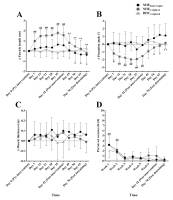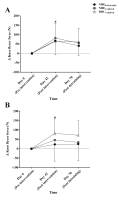Razor hamstring curl and Nordic hamstring exercise architectural adaptations : Impact of exercise selection and intensity
Journal article
Pollard, Christopher W., Opar, David A., Williams, Morgan D., Bourne, Matthew N. and Timmins, Ryan Gregory. (2019). Razor hamstring curl and Nordic hamstring exercise architectural adaptations : Impact of exercise selection and intensity. Scandinavian Journal of Medicine & Science in Sports. 29(5), pp. 706-715. https://doi.org/10.1111/sms.13381
| Authors | Pollard, Christopher W., Opar, David A., Williams, Morgan D., Bourne, Matthew N. and Timmins, Ryan Gregory |
|---|---|
| Abstract | Objectives: To investigate knee flexor strength and biceps femoris long head (BFlh) architectural adaptations following two different Nordic hamstring exercise (NHE) interventions and one razor hamstring curl (RHC) intervention. Methods: Thirty recreationally active males performed a total of 128 reps of NHE<sub>bodyweight</sub> (n = 10), NHE<sub>weighted</sub> (n = 10), or RHC<sub>weighted</sub> training (n = 10) across 6 weeks. Following the intervention, participants avoided any eccentric training for 4 weeks (detraining period). Strength results during the NHE and RHC were recorded pre‐ and post‐intervention, as well as following detraining. Architectural characteristics of the BFlh were assessed weekly throughout the intervention and detraining periods. Results: For the NHE<sub>weighted</sub> group, NHE strength increased (+81N, P = 0.044, d = 0.90) and BFlh fascicles lengthened (+1.57 cm, P < 0.001, d = 1.41) after 6 weeks of training. After 1 week of detraining, BFlh fascicle lengths shortened, with the largest reductions seen in the NHE<sub>weighted</sub> group (−0.96 cm, P = 0.021, d = −0.90). Comparatively, BFlh fascicle length and NHE strength responses were moderate in the NHE<sub>bodyweight</sub> group and negligible in the RHC<sub>weighted</sub> group. The greatest RHC strength changes (+82N, P = 0.038, d = 1.15) were seen in the RHC<sub>weighted</sub> group. Conclusions: NHE<sub>weighted</sub> interventions induce large BFlh fascicle lengthening responses and these adaptations decay after just 1 week of detraining. NHE<sub>bodyweight</sub> training has a moderate impact on BFlh architecture while the RHC<sub>weighted</sub> group has the least. Weighted NHE and RHC training promoted exercise‐specific increases in strength. These findings suggest that exercise selection and intensity should be considered when prescribing exercises aiming to increase eccentric strength and BFlh fascicle length. |
| Keywords | eccentric training; fascicle length; muscle architecture; ultrasound |
| Year | 2019 |
| Journal | Scandinavian Journal of Medicine & Science in Sports |
| Journal citation | 29 (5), pp. 706-715 |
| Publisher | John Wiley & Sons Ltd |
| ISSN | 1600-0838 |
| Digital Object Identifier (DOI) | https://doi.org/10.1111/sms.13381 |
| Scopus EID | 2-s2.0-85061048479 |
| Open access | Published as green open access |
| Page range | 706-715 |
| Research Group | Sports Performance, Recovery, Injury and New Technologies (SPRINT) Research Centre |
| Author's accepted manuscript | License All rights reserved File Access Level Open |
| Publisher's version | License All rights reserved File Access Level Controlled |
| Output status | Published |
| Publication dates | |
| Online | 05 Feb 2019 |
| Publication process dates | |
| Accepted | 07 Jan 2019 |
| Supplemental file | License All rights reserved File Access Level Open |
| Supplemental file | License All rights reserved File Access Level Open |
| Supplemental file | License All rights reserved File Access Level Open |
| Supplemental file | License All rights reserved File Access Level Open |
| Supplemental file | License All rights reserved File Access Level Open |
https://acuresearchbank.acu.edu.au/item/86q3x/razor-hamstring-curl-and-nordic-hamstring-exercise-architectural-adaptations-impact-of-exercise-selection-and-intensity
Download files
Author's accepted manuscript
| AM_Pollard_2019_Razor_hamstring_curl_and_Nordic_hamstring.pdf | |
| License: All rights reserved | |
| File access level: Open | |
Supplemental file
| 0-Pollard_2019_SUPP_Figure1.tif | |
| License: All rights reserved | |
| File access level: Open | |
| 1-Pollard_2019_SUPP_Figure2.jpg | |
| License: All rights reserved | |
| File access level: Open | |
| 2-Pollard_2019_SUPP_Figure3.jpg | |
| License: All rights reserved | |
| File access level: Open | |
| 3-Pollard_2019_SUPP_Table1.pdf | |
| License: All rights reserved | |
| File access level: Open | |
| 4-Pollard_2019_SUPP_Table2.pdf | |
| License: All rights reserved | |
| File access level: Open | |
Restricted files
Publisher's version
595
total views1606
total downloads0
views this month6
downloads this month

